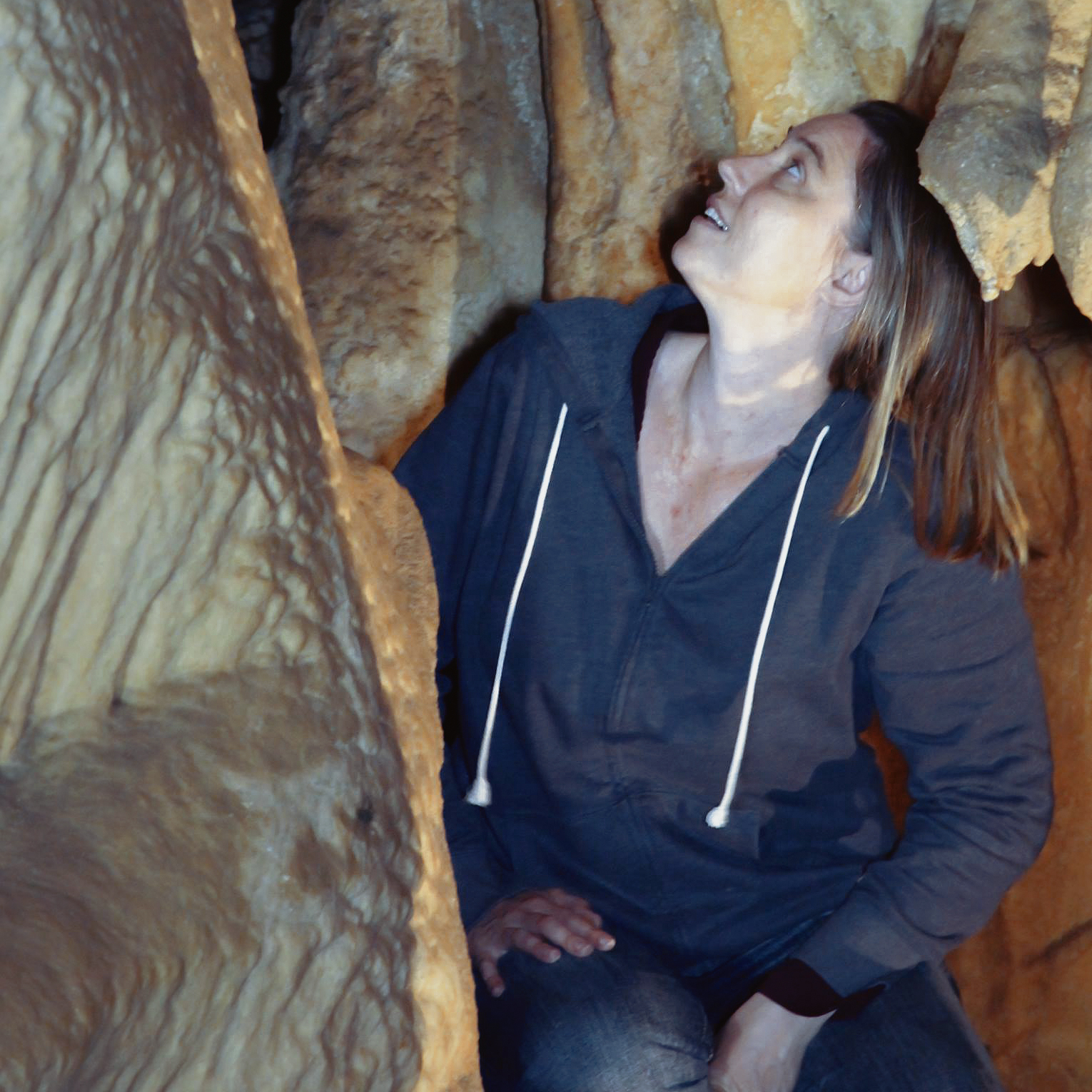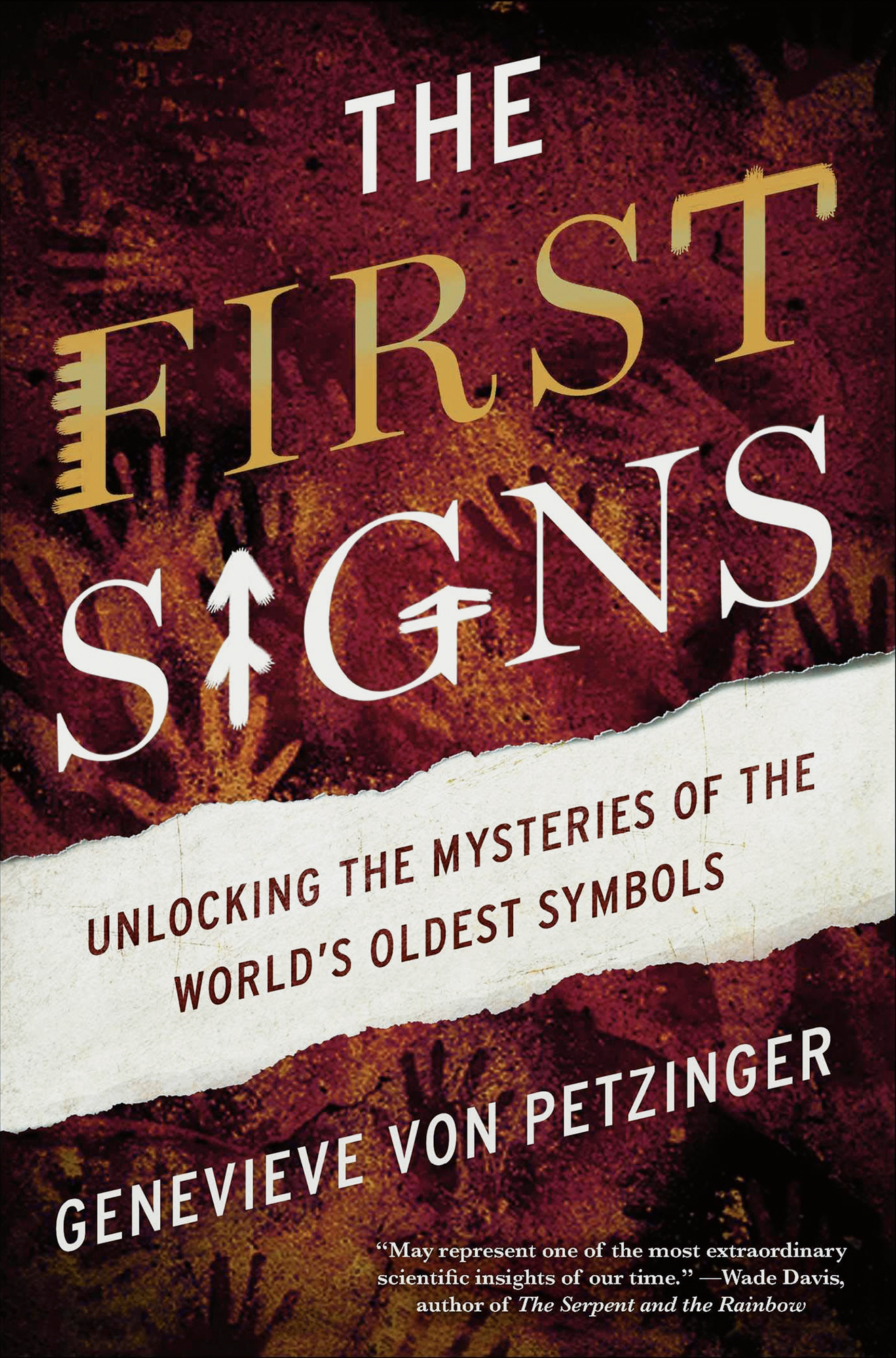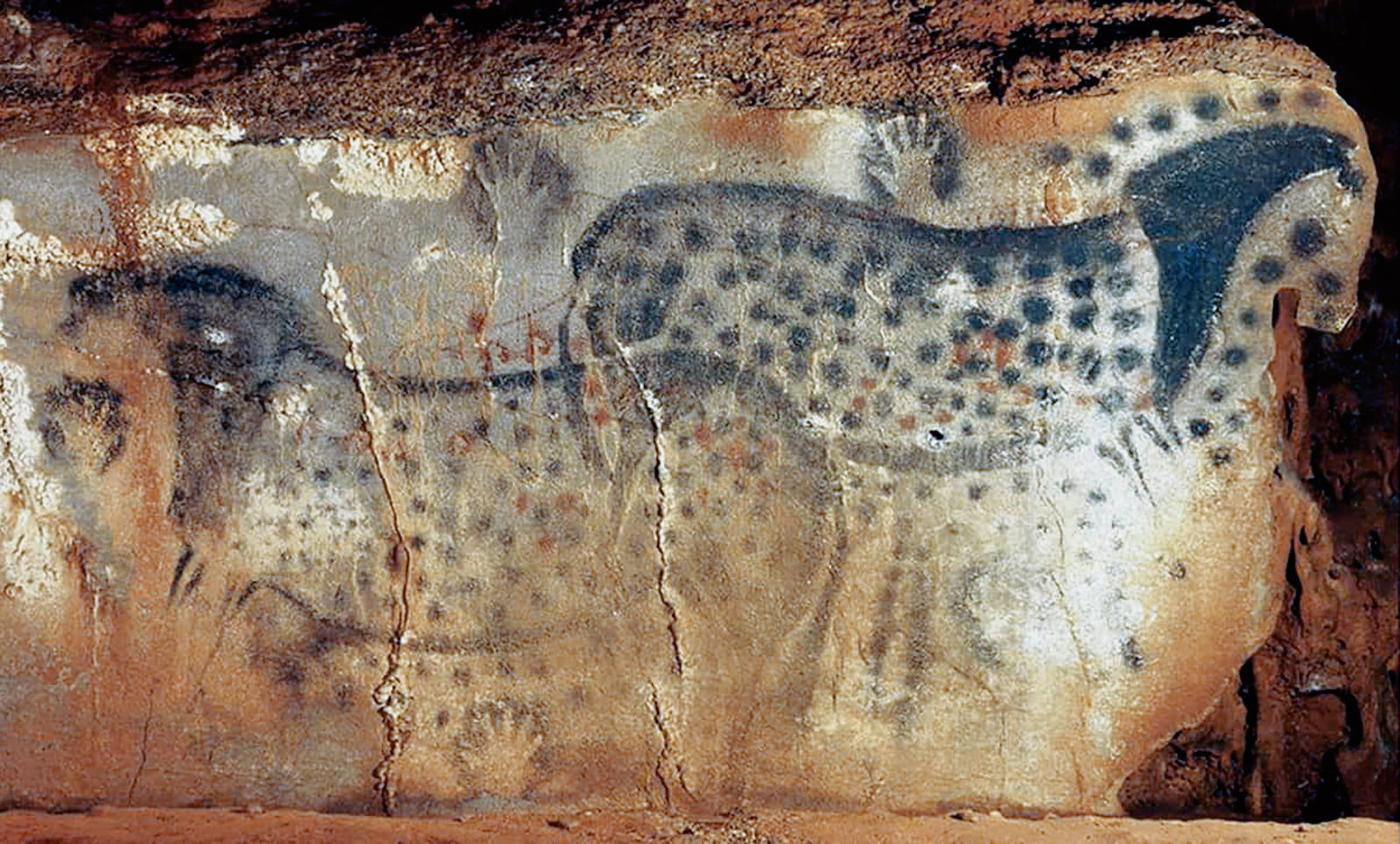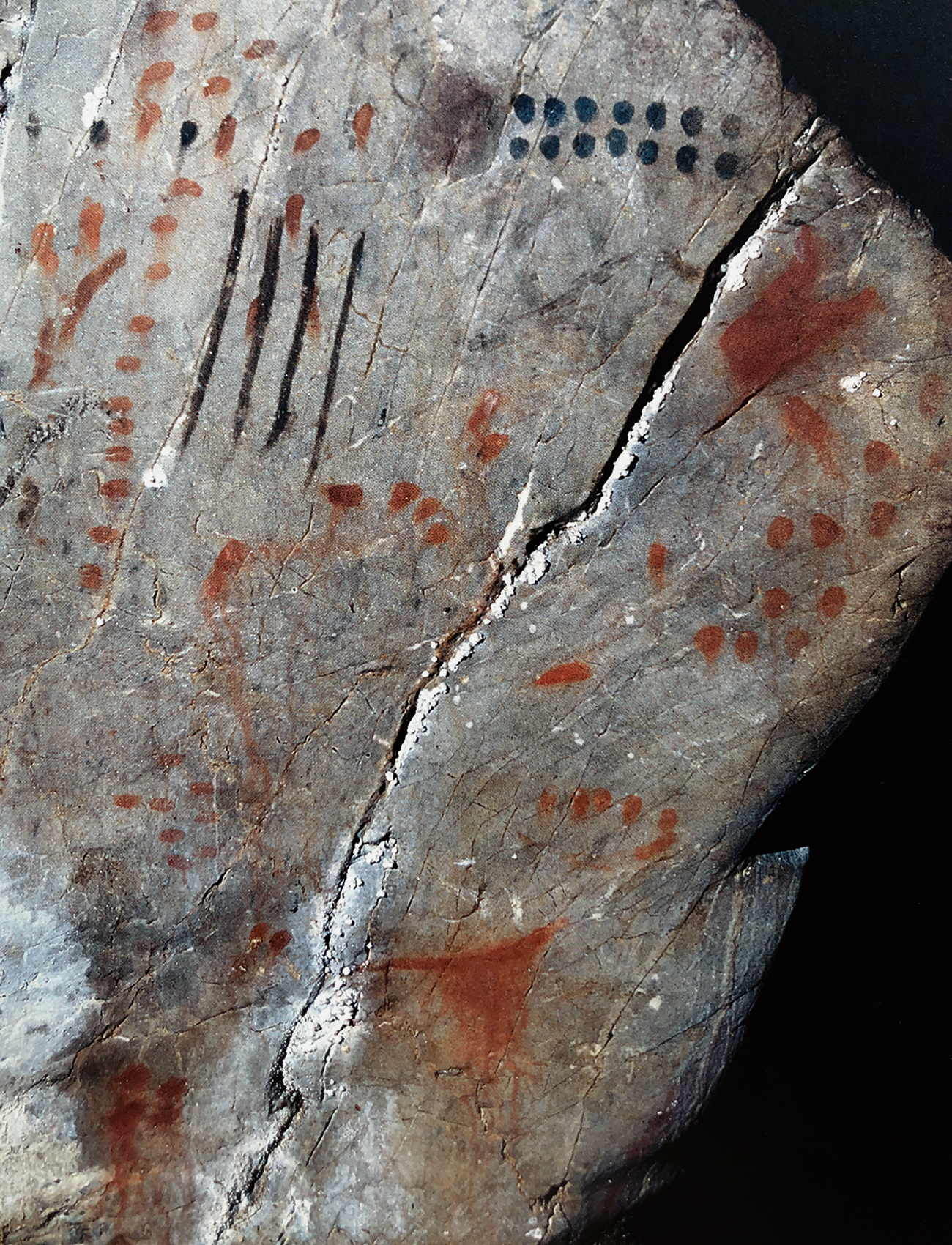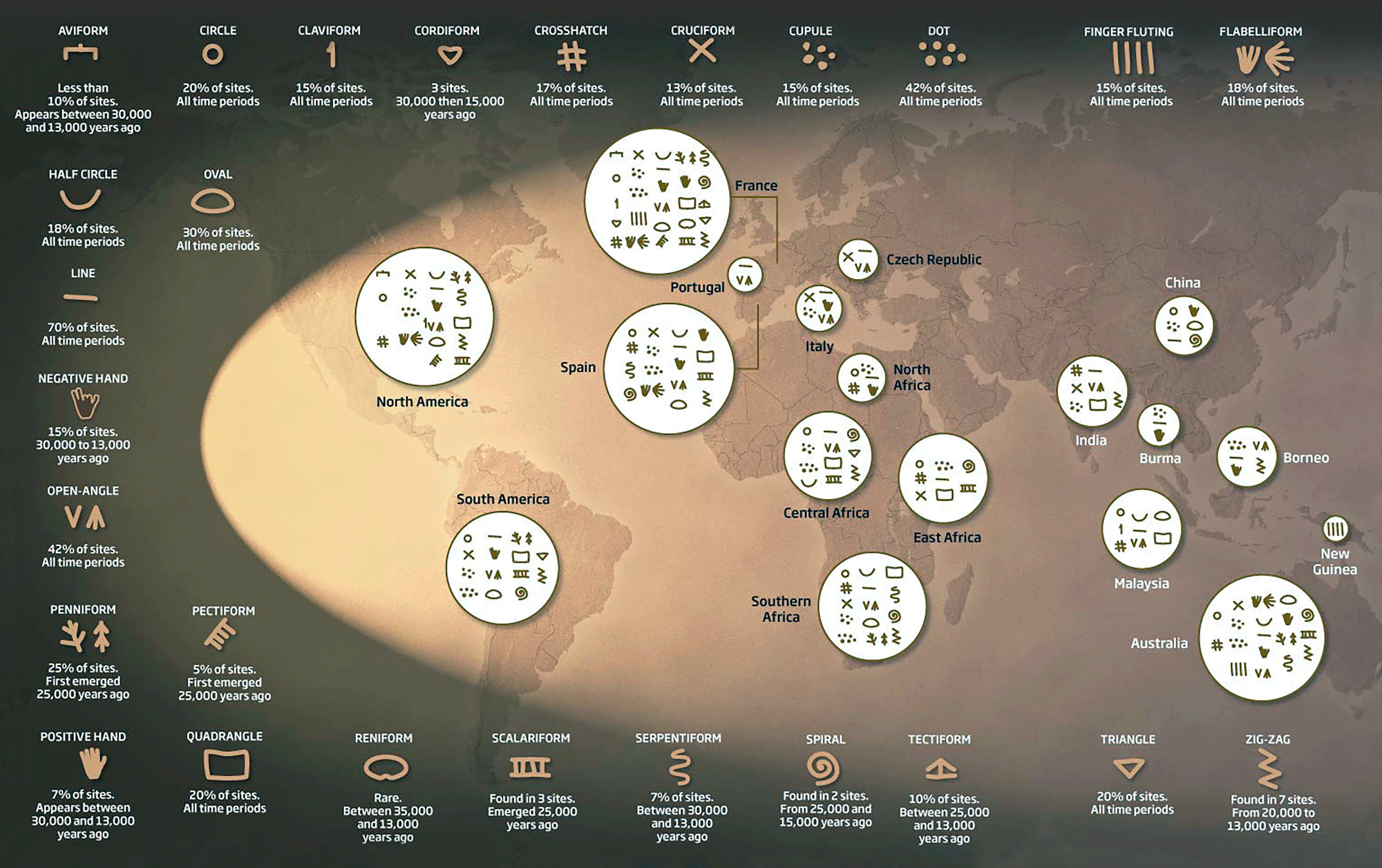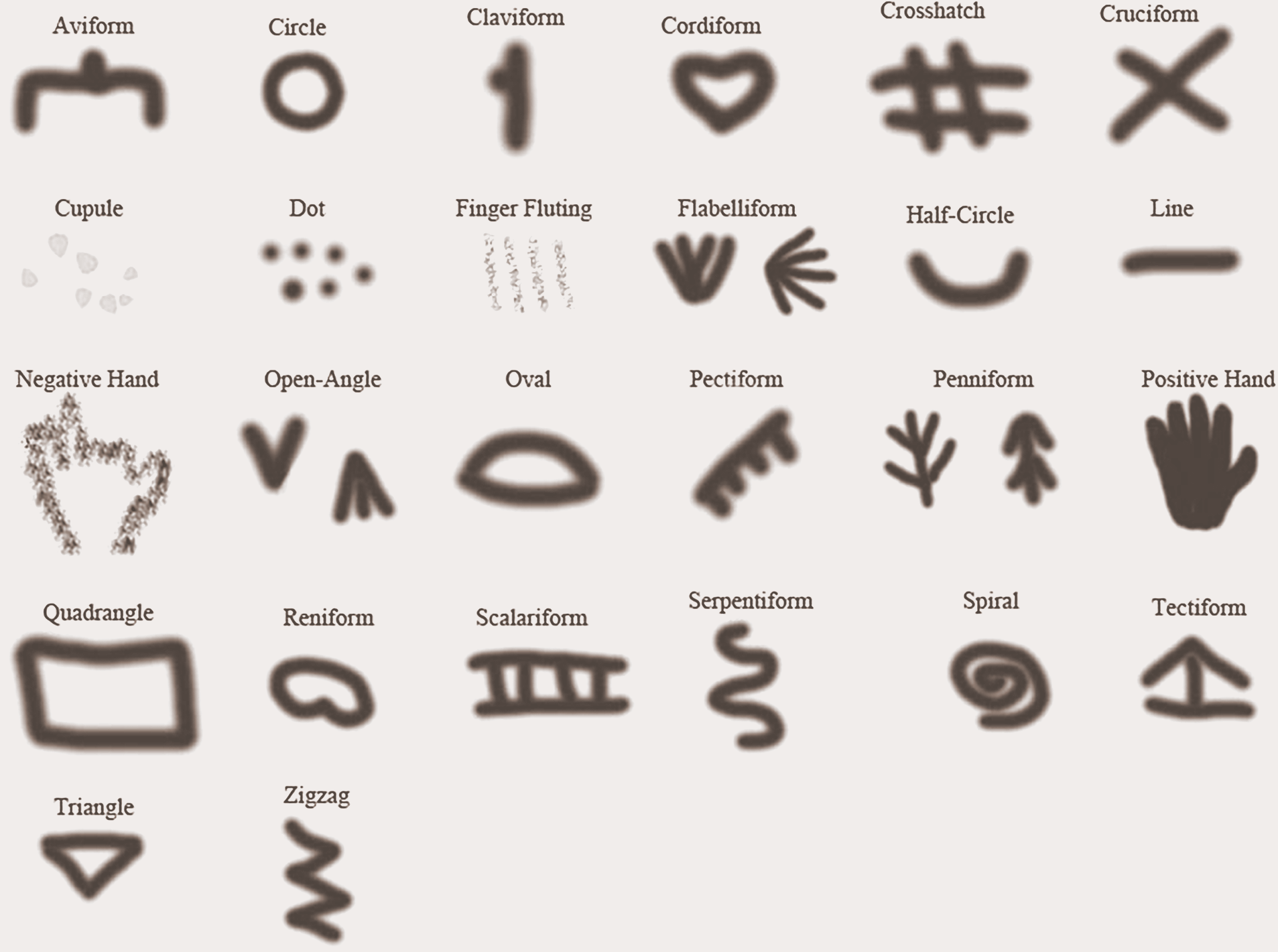


In 2010 Genevieve von Petzinger, based in Canada, initiated an unprecedented survey of ancient geometric signs.
Geometric signs have long been considered as important, and no cave art researcher has neglected them, at least since Leroi-Gourhan’s seminal work in the mid-1960's. What is new and exciting in Genevieve von Petzinger’s research is, thanks to the possibilities of the computer, she has completed a data base of the geometric signs from 146 painted caves, attempting to analyse their relationships to one another.
Genevieve, who has recently completed a MA degree in Anthropology at the University of Victoria in British Columbia, Canada, is researching the geometric signs present in rock art sites in Ice Age France. Her MA research focused on their large-scale temporal and spatial patterning.
Are geometric signs the first step towards symbolism? This might be the case in some contexts, for example at Blombos in South Africa towards 75,000BP, or in Australia with the Panamaritee style. Dr Jean Clottes, however, feels this is not so in the European painted caves: the signs in the caves are always (or nearly always) associated with animal figures and thus cannot be said to be the first steps towards symbolism; besides, the animal figures are probably as symbolic as the signs.
Such is the case in the Niaux Cave, in the foothills of the French Pyrenees. The main entrance to Niaux leads into a large and even-floored cavern, wide and high-ceilinged. The cave walls are smooth and clear, but empty of cave art. For the first 400 metres there are no paintings or engravings. But at a particular point the open cavern becomes restricted, caused by an ancient collapse of enormous jagged boulders from the ceiling. Here there is a choice - one can continue into the cave by climbing with considerable difficulty up over the debris, or else squeeze through a narrow but level passage to the left. As one emerges from this, and on either side of the opening, the paintings begin as symbols. Simple linear lines in red seem to mark the beginning of the painted cave; the beginning of the experience. These enigmatic and understated decorations continue, with a hundred or so red and black geometric signs - dashes, bars, lines, and series of dots - some painted using tools, some using fingers. The red is hematite, the black is either manganese dioxide or charcoal, both ground and mixed with water or fat. They have been daubed strategically, sometimes opposite each other, sometimes on either side of a conspicuous fissure. Shortly after this, the animal figures appear, and the prehistoric dialogue continues to unfold.Are the geometric signs a scripture that can eventually be deciphered? More research must be carried out before we answer this. At the moment, our understanding of geometric signs is that they do not have the characteristics of 'writing', which entails not only ideograms or pictograms (whose diverse meanings are entirely cultural). Moreover, they do not have a syntax. If there are not the systematic repetitions to be found in a well ordered syntax, we will never be able to guess at the precise meaning of the ideograms or even less at their organization within a panel.
When the topic of rock art from Ice Age Europe is mentioned, the first thing that comes to mind for most people is the spectacular animal imagery. Whether it is the bulls of Altamira, the ‘Chinese’ horses of Lascaux, the mammoths of Rouffignac or the rhino and lion paintings at Chauvet, Paleolithic art and animals are tightly intertwined. The artistic mastery shown in the rendering of the animals cannot be denied, but what about all the geometric signs that so often appear around or near the animals at the same sites?
I was an undergraduate student when I first learned that the geometric signs outnumbered the animal and human imagery at most sites by a ratio of 2:1 or greater (Bahn & Vertut 1997: 166). From that moment onwards I was completely fascinated.
I believe that the abstract nature of these signs is some of the best proof we currently have that these images were not being made purely for their aesthetic quality. It suggests a more symbolic role for these markings, and a desire to communicate ideas that were not necessarily easy to depict in a physical form.
(Graziosi 1960: 185)
What Andre Leroi-Gourhan considered to be the "most fascinating area of Paleolithic art" (1979: 350) has tended to be overlooked in favour of the more visually impacting paintings and engravings of animals and humans. The meaning of these symbols is unclear and identification is difficult. This has led to their study being overshadowed by the artistic implications inherent in the figurative depictions. While my initial examination found a great deal of variety among non-figurative sign types, there also appeared to be a surprising degree of continuity, both spatial and temporal.
When I started this research, I discovered that there had not been any large-scale work done on looking at the connections between the geometric signs at different sites or on asking questions such as "are we seeing repetition and continuity which would imply that these representations were not random, and were instead being chosen from within a limited number of options?" While I did go to France and visited some of the caves in person to get a feel for how the images looked in real life, the majority of my research was done using the site inventories prepared by researchers who have studied the individual sites in great detail and kept excellent records, both written and in the form of images. I am also by no means the first person to notice the geometric signs. From Lartet and Christy in the 1860s, to Alexander Marshack and Andre Leroi-Gourhan working in the latter half of the 20th century, there have certainly been those who have drawn attention to this enigmatic category. Leroi-Gourhan in particular believed that he was seeing patterns in the imagery, but he remained focused more on the internal structure of the sites, and did not have at his disposal the kind of computer programs that I was able to use.
I think the availability of technology has really changed the way we are able to do research. I am certain that there were past researchers who would have liked to study the signs in the way that I have, but without the software programs that I had available to me, there is no way that it could have been done at the speed that I was able to do this, nor would they have had such easy access to the data once it had been collected.
(Forbes & Crowder 1979: 350)
There were two especially significant findings that came out of this study. The first was the early age at which we already see 70% of the signs being used. There is an ongoing debate in this field regarding the timing of the "creative explosion" that is generally seen to mark the beginning of symbolic behaviour in modern humans (Bar-Yosef 2002). Art (both rock art and portable), musical instruments, body ornamentation are the archaeological evidence commonly used to identify abstract thinking in modern humans. This behaviour is often thought to have really emerged for the first time during the European Ice Age. However, with the use of geometric signs already appearing to be well-established at that time, it suggests that the origin of this behaviour could have been earlier, possibly even before our distant ancestors left Africa and prior to when the "creative explosion" is often thought to have taken place. Secondly, over time and space there was a high degree of repetition of this limited number of shapes, with some being replicated throughout the 20,000 year time span of my study. This continuity arguably removes any previous speculation that these signs were random doodles, as we would expect to find more variety if this were so. Based on these results, I was able to conclude with a fair degree of certainty that there was intentionality and that they were making conscious choices about which signs to use at a site (no sign type appears everywhere).
Regarding meaning, while I do not know if we will ever be able to decipher exactly what any sign means, I do think that the geometrics probably represent abstract ideas or concepts that were important to those who created them. The way I approached meaning for my study was to look at it indirectly - with such a limited number of signs being used for over 20,000 years across the whole region of France, I do not need to know exactly what they meant to know that they were obviously important to the people who drew them. By this I mean that repetition of the same sign for so long, and the choices that they were making regarding what to portray in each site point towards intentionality. No sign appears everywhere, so they were obviously making decisions as to what they should represent rather than anything being an automatic inclusion.
I know that a lot of people would like to think that the signs are writing, but I do not believe that this was a full-blown writing system like those found in later cultures which include structural elements such as grammar and sentence composition. Probably a better way to describe it would be that this was a foundational step for our ancestors in communicating with each other in a physical form. From my limited understanding of linguistics, I believe this behaviour is generally seen to be the first step towards writing, and is usually described as being iconographic at this stage, or is categorized as an ideogram. This focus on the geometric signs is not meant to exclude the likelihood that the animal and human imagery also had a more symbolic meaning than just being representative. Leroi-Gourhan referred to the whole body of art as the "language of the Upper Paleolithic" (1992), and he may very well be right.
I believe the signs are so interesting because they are abstract, and therefore completely symbolic, making it much more difficult for us to understand what they mean. However, at the same time they provide good evidence of the complex thinking and communication that our ancestors were capable of. Concentrating on France kept my MA research a reasonable size, and allowed me to use it as a test case to see if this type of trending was even possible to do. Now that I know it is feasible, one of the main goals of my PhD research will be to expand this database to include all known rock art sites in other countries and regions in Eurasia. This should result in there being about triple the sites that I currently have documented. These countries include Spain, Portugal, Italy, the UK, Russia, the Czech Republic and Slovakia so far, though I am still hopeful that I will be able to find sites in other countries as well.
I believe Spain will be especially important because there are almost as many decorated sites as in France, and a preliminary survey suggests very strong similarities in the sign types between these two regions. I am also very interested in learning more about rock art in Central and Eastern Europe, as I think this part of the continent could play a very important role in understanding the larger implications of what was going on during this period. The research I have done so far is really just scratching the surface, and I believe that it will be during my next phase of expansion that the really interesting temporal and spatial trends will start to emerge.
The Paleolithic caves of France are famous for their prehistoric rock art. Along with the animal and human imagery, 26 symbols have appeared repeatedly. These symbols appear in other parts of the world as well, leading to the possibility that symbolic communication through geometric signs arose with early humans. The diagram below shows regions around the world where the these 26 symbols have been found. You can click on each geographic sign for more information.
(Source) Genevieve von Petzinger, Andre Leroi-Gourhan, David Lewis-Williams, Natalie Franklin
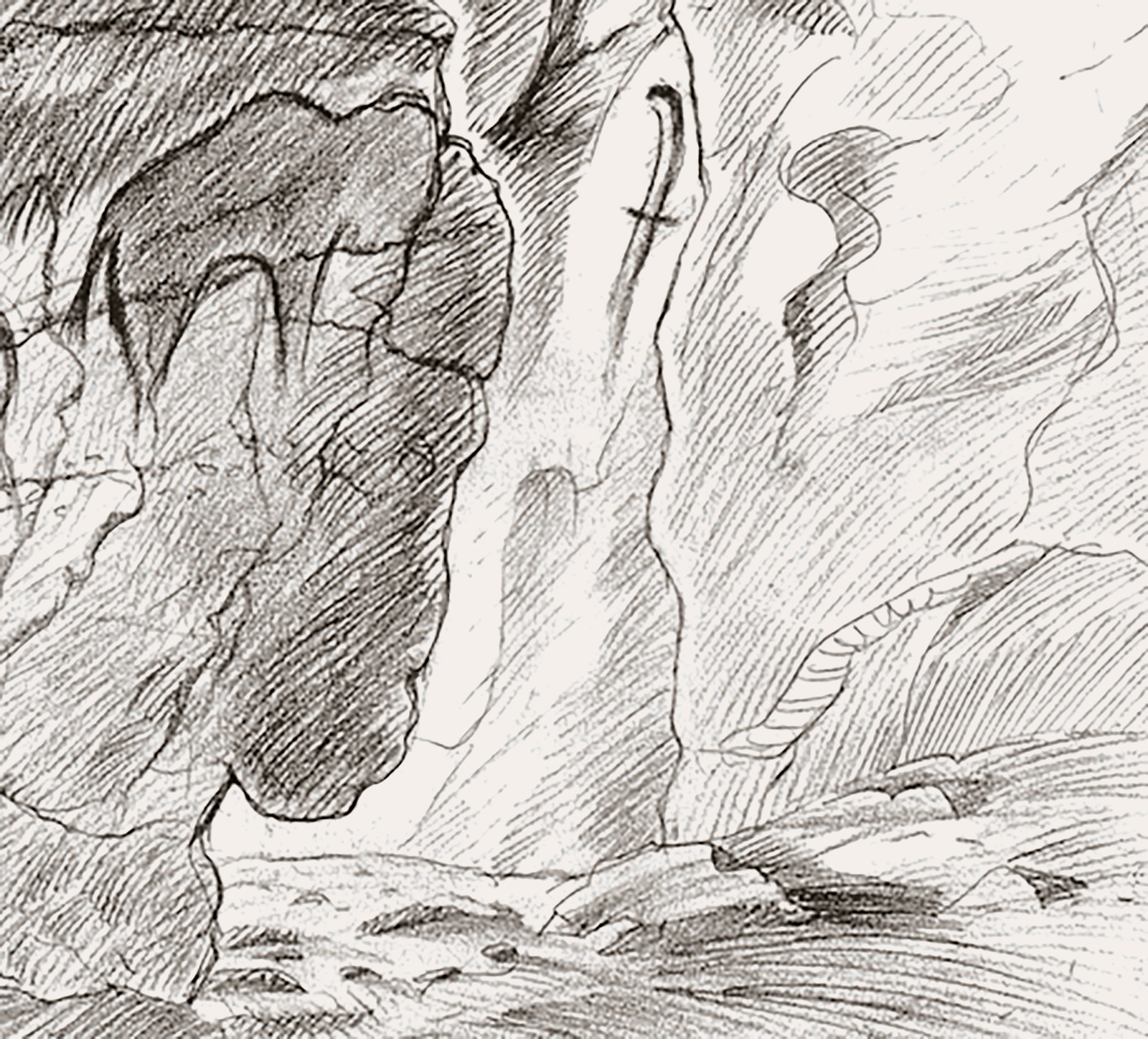
This term comes from the Latin name for 'hook-shaped', and it is a new addition to my typology. The unciforms I have found so far seem to come in two varieties: those with a line (or lines) bisecting the middle of the sign, and those that are just a simple hook. Another name that I found for this sign type was "crochet", which means hook in French, and this was used by Lorblanchet in his inventories of sites in the Lot region of France (2010: 227, 315).
Since I have only recently added the unciform sign type to my typology, my search for examples of this abstract shape is ongoing. To date, I have identified unciforms at five different sites, though this number will probably continue to increase over time. It appears for the first time at the Aurignacian site of Grotte Chauvet (see drawing below), and is also present in the Gravettian (1 site), the Solutrean (1 site), and the Magdalenian (2 sites). Geographically, there are 2 sites each in the SW and SE of France, and 1 site in the Pyrenees near Spain. Because of the one site close to the many rock art sites of N Spain, it will be interesting to see if I find any examples of unciforms in this country as I continue to expand my database.
New - bibliographic information for this sign type:
Lorblanchet, M. 2010. Art Pariétal: Grottes Ornées du Quercy. Arles: Le Roergue.
Drawing of unciform with one bisecting line in Grotte Chauvet: in Chauvet, J.-M., Brunel-Deschamps, E. and Hillaire, C. 1995: La Grotte Chauvet à Vallon-Pont-d’Arc, (Paris), page 76.
Drawing of unciform with bisecting line in Grotte Bayol: in Leroi-Gourhan, André, Brigitte Delluc, and Gilles Delluc (eds) 1995. Préhistoire de l'Art Occidental. Paris: Citadelles et Mazenod, page 566.
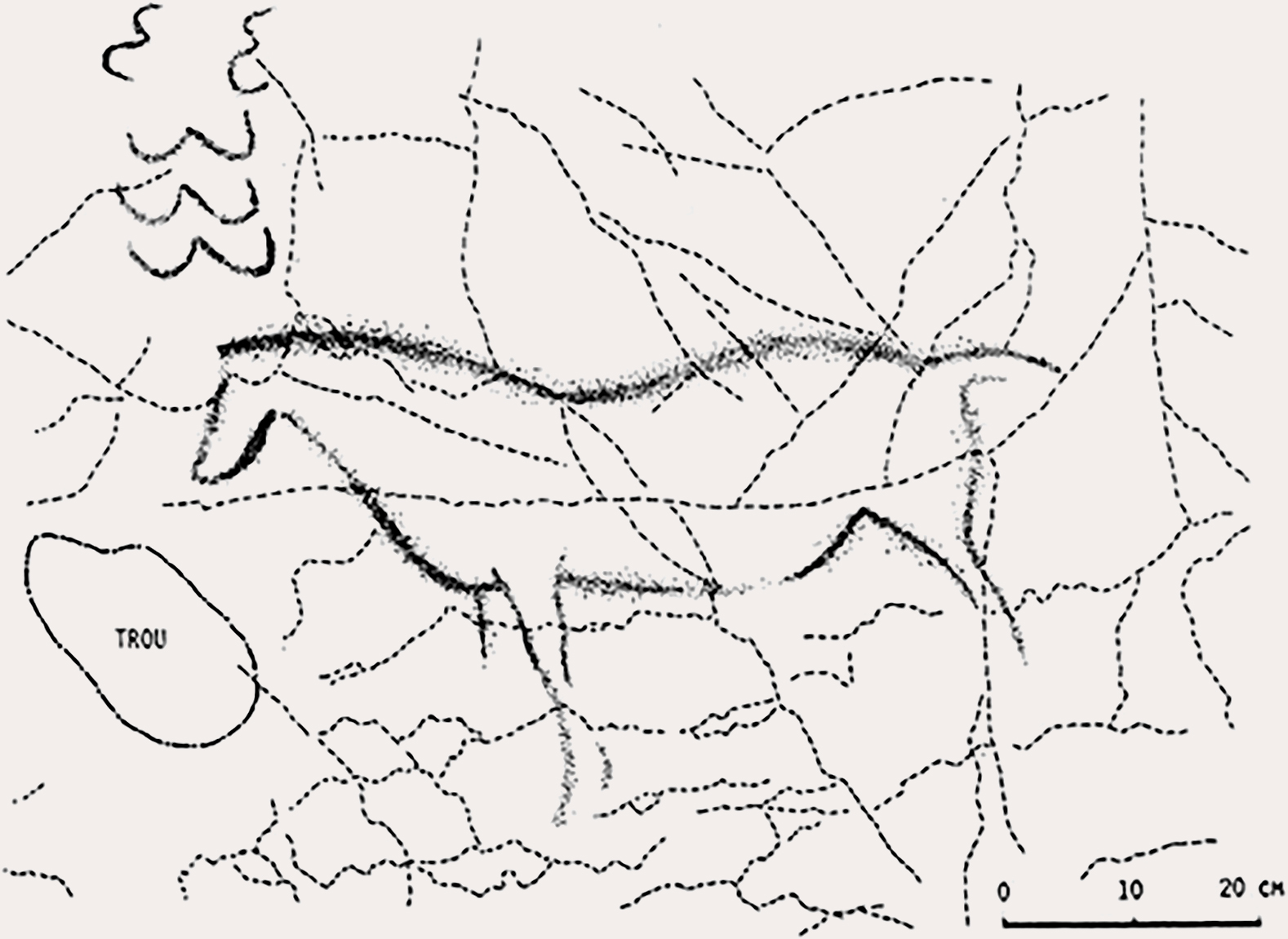
This sign type is a fairly recent addition to my typology, and as such, remains a work in progress. I first became aware of the W-sign after seeing an article about the French site of Chauvet, where there are 17 of these sign types present, both engraved and painted (Azéma and Clottes 2008). While I had read descriptions in site inventories elsewhere that mentioned a sign that was ‘curvilinear’ or shaped like a ‘cursive w’ (Lorblanchet 1984: 458), this was the first time I actually got to see what it looked like. While the 2008 article refers to these signs as being ‘Chauvet-type signs’, I decided to call them W-signs as I felt it was more descriptive of their shape, and less France-specific, since I am also planning to look for them elsewhere.
So far I have found W-signs at seven different sites in France, though I suspect that this number will rise now that I am actively looking for them. It appears for the first time at the Aurignacian site of Grotte Chauvet , and is also present in the Gravettian (1 site), the Solutrean (2 sites), and the Magdalenian (3 sites). There is an interesting geographic distribution pattern to these sites, with four of them grouped quite tightly together in the district of Lot in SW France, two more near each other in SE France, and then a single site near the base of the Pyrenees. As I identify more examples of this sign type in France, it will be intriguing to see if they are also found in the same vicinity as the existing sites. As well, I have heard that W-signs are present in Spain, so locating these neighbouring examples might help illuminate a clearer distribution pattern.
Abstract Shapes
Not immediately recognizable as a "mundane" object. This is why they are also referred to as non-figurative images, as opposed to figurative imagery like animals or humans. These signs are made using all the same techniques (painting, engraving, etc.) as the figurative art, except for sculpting.
Where do we find them?
They are found on the walls, ceilings and floors in caves and rock shelters, as well as on portable art objects. They are found in isolated locations at a rock art site, either singly, or in groupings. They are also found in association with animal and human imagery.
| Sub-divisions of the Ice Age into Stylistic Periods (From Clottes 2008) |
||
| Name of Period | From | To |
| Aurignacian | 35,000 years ago | 28,000 years ago |
| Gravettian | 28,000 years ago | 22,000 years ago |
| Solutrean | 22,000 years ago | 17,000 years ago |
| Magdalenian | 17,000 years ago | 13,000 years ago |
| Late Magdalenian | 13,000 years ago | 10,000 years ago |
The Worldwide Geometric Signs Chart contains a brief overview of each of the sign types that I identified and worked with throughout my MA research. As I now embark on my PhD, it is important to remember that this typology is far from finished. As I begin to add other countries and regions, as well as re-visiting some of the distinctions that have been made between different abstract shapes, there is a definite possibility that more categories will be added, while others may be revised. Having said that, this typology still acts as an excellent tool with which to study the geometric signs, and some of the results of this survey of Ice Age France are quite fascinating and suggestive.
Other than some difficulties in accumulating sufficient data for each site, probably the most challenging part of this project was creating a typology of the French geometric sign types out of several regional versions. Gonzalez Morales has cautioned that we must be aware of the possibility that these categories were created because they appeared to have the same meaning to the researcher, rather than having been organized this way by the artist (1997: 195). Many of the earliest sign types were assumed to be narrative, or pictographic in nature, and were named accordingly using a Latin-based typology (for example penniform = spear or arrow, tectiform = hut or animal trap, and claviform = club), as well as being based on a hunting magic interpretation (Bahn & Vertut 1997: 167). Bahn has suggested that while these interpretive names are no longer taken literally, they are now so embedded in the literature, that they have been retained as general descriptions of certain sign type shapes (1997: 167). Based on this, I included these descriptive category names in my typology since they are the most widely recognized designations (see below for the full description of each of these categories within the typology).
With different researchers working in each of the regions, often at separate times, some of them chose to use alternate category names, or grouped the non-figurative imagery in a different way. This resulted in some confusion when trying to ascertain whether geometric signs from two different sites were in fact the same (especially if there were no images), which was necessary during the creation of an amalgamated typology. Part of the issue with multiple names for the same abstract shape seemed to stem from the desire of later researchers to distance themselves from the early interpretive names. In an attempt to be more objective, what used to be called an arrow is now sometimes identified as "a chevron with a median longitudinal line" (Bahn & Vertut 1997: 174), but if not everyone is using the same criteria; this unfortunately does not really fix the problem. Within this overview, I will be defining the significant characteristics of each sign type, as well as acknowledging the alternate names which I have collapsed into each category.
One other important thing to keep in mind when it comes to the distribution of sign types across the time period of the Ice Age is the problem of differential preservation. The further back we go, the less likely we are to find sites intact. For example, 75% of cave and rock shelter sites from the Aurignacian period have had their walls and ceilings collapse, and all we have left are the markings found on broken blocks and fragments of rock at these sites. In nearly all of these cases, it is the engravings that have survived, since they endure the weathering process a lot better than the paintings. There are also several sites such as La Ferrassie, Abri Castanet and Abri Belcayre, where all we have on the blocks are remnants of what were paintings when they were on the walls. Since many of the blocks fall face down, the paint tends to come off, leaving us with only faint hints of what used to be on them. This has resulted in the Aurignacian period in particular, being labelled as consisting mostly of engravings. But when the circumstantial evidence such as paint flakes, and partial paintings on fragments is taken into consideration, the reality is probably that there was a more even mix of both, but it is difficult to prove.
What this means for us as archaeologists studying these sites, is that while we can tell that these sites used to be decorated with both paintings and engravings, we are no longer able to tell what the majority of the paintings were. And when it comes to identifying specific images, both for figurative and non-figurative representations, we know that we are at a real disadvantage with the old sites since so much has been lost. This is one of the reasons that the discovery of the site of Chauvet in 1994 was so important to this field of research. With Carbon 14 dating this site to older than 28,000 years ago, and over 450 painted and engraved images identified so far, Chauvet is allowing us to learn more about the earliest days of rock art in Europe, as this is a rare site where the imagery remains largely intact on the walls.
Since the making of rock art is an ongoing practice in many regions of the world including Australia, Africa and North America, I have focused on the oldest art, thought to have been done either during or soon after the Upper Paleolithic. The dating is far from certain for the majority of sites, so some may as be as late as the Iron Age. If rock art is done by engraving or with red paint, it is very difficult to pinpoint a time period as there is nothing to use C14 dating on. While there are other dating methods being used in some of these cases, many of these methods are more controversial, and the debate continues.
In locations where people continue to make rock art, studying sites, both past and present, can be difficult as there are often religious connotations surrounding this practice. The result can be an understandable reluctance to allow outsiders access to sites, and means that the diversity of motifs may be much larger than is currently known.
This survey of non-figurative rock art imagery from outside the French region should be treated as preliminary only. I have only included sign types that I was familiar with, or that I was able to visually confirm, which means that I may very well have accidentally omitted geometric shapes present in some of these locations. The following section contains notes that I have made about different aspects of this overview (often including source material). Below this can be found a chart which lists out as many countries/regions as possible that have geometric signs, and specifying which ones are present.
Negative Hands
This sign type appears in nearly all regions of the world. For an excellent overview of this phenomena and to see some beautiful pictures, check out the Bradshaw Foundation article about this topic.
Europe
The majority of the information about geometric signs at Spanish sites comes from the work of Andre Leroi-Gourhan. Much of the information I found for other countries comes from an excellent online database site (sponsored by the EU), called ‘Europreart’. It contains listings for many rock art sites in W. Europe, including images, and is well worth exploring: www.europreart.net.
Georgia
There is mention of “ancient rock art symbols” being present in this country, but I could not find any breakdown of sign type. This will definitely be an area of further research for my PhD.
India
While there is still an on-going debate about the age of the art, and whether it actually dates to the Upper Paleolithic, some is thought to date right from the end of that time (approx. 10,000 BP). The information about what geometric signs are present at these sites (I only included those attributed to the oldest time period), is from Dr Jean Clottes’ article found on the Bradshaw Foundation website at the following URL: https://www.bradshawfoundation.com/india/index.php.
Borneo
Some of the information for this country comes from the Bradshaw Foundation negative hands article (see above) and a National Geographic article: http://ngm.nationalgeographic.com/features/world/asia/indonesia/cave-art-text.
Myanmar and Malaysia
Information about rock art in these countries is extremely limited at the moment, mainly due to a lack of funds for research in these countries. This may now be changing, and an excellent overview on this and other Asia/South Pacific rock art is available at the following URL: http://13congresoantropologia.uniandes.edu.co/_documentos/Illustrating the Past.pdf.
Africa
There was enough information for me to differentiate somewhat between regions when it came to the presence of geometric signs, though I would say that what I was able to identify is far from a complete list - so please keep that in mind! The African regions I used as categories breakdown as follows: Western Central Africa: Gabon, Cameroon, Central African Republic, Congo. East Africa: Tanzania. North Africa: Algeria, Libya, Niger, Chad. Southern Africa: Namibia, South Africa, Mozambique, Zimbabwe.
Much of the information for this continent came from Dr David Lewis-Williams’s book "The Mind In the Cave", and journal articles he has published (he is a researcher out of S. Africa who has done a fair amount of research on some types of geometric signs as part of his work on shamanism). Also, I pulled information from the Bradshaw Foundation website which has an entire section on African rock art. Another excellent source for material on Africa is the "Trust for African Rock Art" (TARA).
South America
There are probably a lot more countries and sign types than I have included, but research in this region has been limited in many cases by lack of funding. I included signs if I could find a listing or a visual representation, so there could very well be more than I have accounted for. As well, there are not a lot of dates from this region, so much of the art is probably later than the Upper Paleolithic. Countries included are Bolivia, Argentina and Brazil, and the information about the geometric signs in Bolivia comes from the Bradshaw Foundation: https://www.bradshawfoundation.com/bolivia/index.php
Bahn, Paul G. and Jean Vertut
Journey Through the Ice Age. Berkley: University of California Press; 1st edition, 2001.
Clottes, Jean
Cave Art. London: Phaidon Press Limited, 2008.
Davis, Whitney
"Replication and Depiction in Paleolithic Art" in Representations, No. 19 (Summer 1987), pp. 111-147. (Abri Blanchard, Abri Cellier, Castanet, La Ferrassie)
Graziosi, Paolo
Palaeolithic Art. New York: McGraw-Hill Book Company Inc., 1960.
Gonzalez Morales, Manuel R.
"When the Beasts Go Marching Out! The End of Pleistocene Art in Cantabrian Spain", in Conkey, Margaret W., Olga Soffer, Deborah Stratmann and Nina G. Jablonski (eds). Beyond Art: Pleistocene Image and Symbol. Berkley: University of California Press, 1997. Pp. 189-199.
Gould, Stephen Jay
"Up against a Wall" in Natural History. Vol. 105, No. 7 (July 1996), pp. 16-24.
Leroi-Gourhan, André, Brigitte Delluc, and Gilles Delluc (eds)
Préhistoire de l'Art Occidental. Paris: Citadelles et Mazenod, 1995.
Lewis-Williams, D.
The Mind in the Cave: Consciousness and the Origins of Art. London: Thames and Hudson 2002.
Lorblanchet, Michel
Multiple site reports and inventories in the Lot Region, in Ministère de la Culture (France). L’Art des Cavernes: Atlas des Grottes Ornées Paléolithiques Françaises. Paris: Imprimerie Nationale, 1984.
Marshack, Alexander
The Roots of Civilization: The Cognitive Beginnings of Man's First Art, Symbol and Notation. Kingston: Moyer Bell Ltd, 1972.
Sharpe, Kevin and Leslie Van Gelder
"The Study of Finger Flutings" in Cambridge Archaeological Journal, Vol. 16, No. 3 (2006), p. 281-295.
Vialou, Denis
La Prehistoire. Egedsa a Sabadell (Spain): Gallimard, 2006.
White, Randall
Dark Caves, Bright Visions: Life in Ice Age Europe (First American Edition). New York: The American Museum of Natural History, 1986.
→ France Rock Art & Cave Paintings Archive
→ Chauvet Cave
→ Lascaux Cave
→ Niaux Cave
→ Cosquer Cave
→ Rouffignac Cave - Cave of the Hundred Mammoths
→ Bison of Tuc D'Audoubert
→ Geometric Signs & Symbols in Rock Art
→ The Paleolithic Cave Art of France
→ Dr Jean Clottes
→ Bradshaw Foundation
→ Rock Art Network
